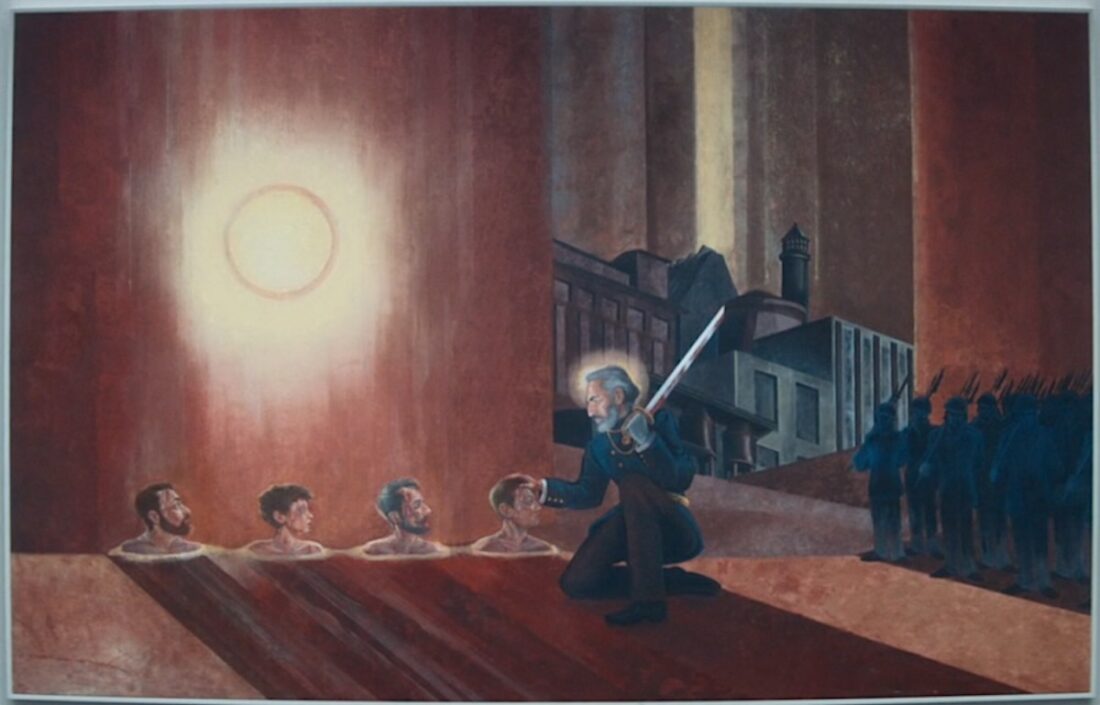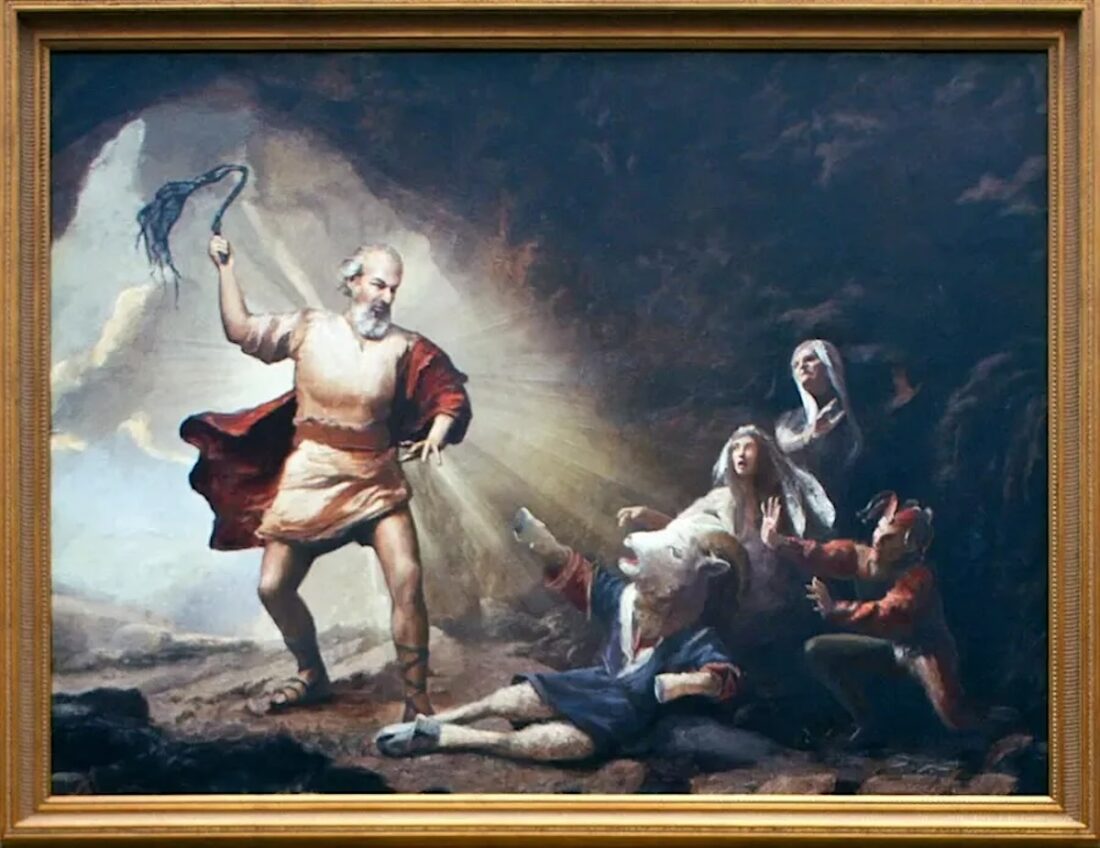One of the first images of the second season of Severance is a meme-worthy painting of the sinister Lumon corporation’s founder, Kier Eagan. Titled “Kier Pardons His Betrayers,” it shows the founder dressed in military costume, a halo around his head, bending down to touch the heads of four figures who are seen from the shoulders up, seemingly submerged in water. From our perspective, the figures are cut off (severed???) from the shoulders down.
The characters in Severance may not have the benefit of an Art History background—even though Irving is an artist and Mark was a History professor, their innies don’t share this expertise. None of the innies seem particularly equipped to (or have the desire to) analyze the paintings for a sense of Lumon’s ultimate goal. Thankfully we can—let’s talk about it.

“Kier Pardons His Betrayers” is mostly painted in red and blue, two significant colors within the visual language of Severance as a whole. Blue signifies “innies,” the split-off consciousness that inhabits a character’s body while they are at work, while red signifies “outies,” the external personalities of the characters. Innies and outies cannot communicate with each other, and are only the same person in a technical sense. In the show, this is communicated through the blue and/or cold tones on the severed floor, while warm tones such as red are shown in the outside world, where severed employees exist as their “outies.”
Let’s look at some examples: in season one, Helly R is always shown wearing blue on the severed floor, but her hair is bright red—a clue to the audience that her outie is someone significant, before it’s revealed that she is Helena Eagan, heir to the company. In season 2, the innie and outie worlds begin to bleed into each other, and we start to see Mark’s outie wearing red—particularly when he’s reintegrating with Reghabi. When Irving B. is fired, the MDR team is treated to a watermelon shaped like his head; the redness of the melon signifies that Irving only exists as his outie now.
We can use this existing pattern to interpret the painting as a statement about the severance process and its significance in Lumon philosophy. The “betrayers” in this painting have a reddish cast to them, indicating they may be “outies” or unsevered people, and the blue Kier figure’s blessing could be the severance process itself—the sword he’s holding could be a symbol of severance. That explains the legion of blue military figures in the background: these are employees who have already been severed. But that’s not all—color symbology from the broader tradition of Western art can help us go deeper. In classical paintings, Jesus and the Virgin Mary are usually depicted dressed in red and blue, with their outfits each inverting the other’s: Jesus generally wears a red robe with a blue shawl/ sash/ cloak, and the Virgin Mary wears blue with ornaments of red. Jesus’s red is often associated with worldly sins, which he suffered to save humanity from, and his blood, representing the crucifixion. Mary’s blue represents purity and the divine, because she was the carrier for God’s child, and her virginity. This tracks with Severance’s usage: outies are the worldly aspect of the self, and for whatever reason, Lumon considers severed employees—specifically their innies—to be purified in some way. In this painting, the blue Kier figure takes the part of the Virgin Mary; this could mean that through severance he’s giving birth to the “innies” of the betrayers. Lumon employees are often told they’re “children of Kier,” which could refer to this religious viewpoint on severance.
This painting brings to mind another that we saw last season, titled Kier Taming the Four Tempers. Behold:

Central to this painting, and Lumon’s view of human nature, is Kier’s concept of the four tempers: woe, malice, frolic, and dread. The jester figure on the right, notably dressed in a mix of red and blue represents frolic. The ram represents malice, due to its associations with aggression (horns) and the devil. The two figures with white headdresses are meant to be a bride (woe) and a crone (dread). Kier taught that “Each man’s character is defined by the precise ratio [of the tempers] that resides in him.” Which leaves us to wonder what a person would be when the tempers were fully tamed?
Unlike the last painting, Kier wears a red robe and carries a blue flail. Here, Kier could stand in for Christ: with the tempers subdued before him, he is presented as the redeemer of mankind. The flail represents the severance procedure, by which the tempers are, apparently, tamed. Kier being symbolized as both Jesus and the Virgin Mary might seem contradictory, but illustrates the duality of man within the Severance world. Everyone at Lumon is both their sinful outie self and their purified, innie self. Thus, they all birth themselves as outie Jesus, who then dies to become their innie, the Virgin Mary. Simple!
In the finale of season two, it’s revealed that Mark and the other Macrodata Refinement employees are purifying their data files of any traces of the four tempers. To “refine” the data, they look for numbers that “feel” certain ways—earlier in the series, Helly identifies a section of “scary” numbers (presumably representing Dread) and bins them, purging them from the file. This essentially means they’re taming the four tempers, just like Kier in the painting. And as far as we’ve been told within the show, severed employees are needed to perform this work, because their state makes them sensitive to the tempers in the data they refine.
The data in MDR’s files represents the tempers in Gemma/ Miss Casey’s brain, suggesting that they’re trying to make her into the perfect severed employee. After all, we see plenty of tempers in the interactions of the MDR characters. However, when we consider Miss Casey alongside the MDR department, we see someone who is quite markedly even-tempered, to the point of her being one of the strangest characters in the show. Which begs the question, with the final “Cold Harbor” file finished, how much more tamed can her tempers get?
If a person’s combination of tempers is their personality, then a person without tempers would be no one. Untainted by the original sin of the tempers, they would be like a baptized baby, free to enter the kingdom of heaven. One character even directly states that he decided to get severed because he thought it would allow his innie’s soul to go to heaven, when the rest of him might not make the cut!
In Season 1, we see a pornographic show where four dancers dress up as sexy versions of the tempers as personified in this painting. The show is supposed to be a reward for Dylan G after a productive quarter. This gives us a glimpse into Lumon’s ideas about sex: if the tempers are sin, and also sexual, then sex is sinful, but then what does it mean if the reward for refining/purifying data of the four tempers is to have sex with their avatars? Perhaps that’ll require a whole other article to unpack…

In Kier Invites You To Drink Of His Waters, Kier appears to own the Great Lakes. If blue equals severance, and blue is (understandably) connected to water within the show’s symbology, that extends the association of severance to water—and wait a minute, Lumon’s logo is a drop of water!
In the episode “Woe’s Hollow,” a throwaway joke might have given us a clue about water in the world of Severance: showing the characters a small woodland waterfall, Seth Milchick cheerfully informs them that it is the tallest waterfall in the world. What if this statement is true? That would mean Niagara Falls and every other large waterfall had either dried up or been subjected to some sort of disaster. What if Lumon controls a significant amount of the water that remains, making it a global superpower?
In the town where Lumon’s headquarters is located, there is snow everywhere—frozen water. The town is called Kier, and most people who live there are employees. The snow, the nearby national park with its rivers, and the big lake right outside Lumon HQ could be a grotesque display of water wealth compared to the outside world. It’s also worth noting that Lumon offers food to employees as a reward for hitting milestones in their work, possibly because food is scarce.
In the final episode of season two, we get one last painting before the break between seasons. “The Exalted Victory of Cold Harbor” shows Mark S. in the center, with all the characters in the show arranged around him, calf-deep in a pool of water beneath the “tallest waterfall in the world”. All the past CEOs of Lumon (and presumed-future CEO Helena Eagan) are shown standing above the characters, at the top of the waterfall. The CEOs are shown as aligned with the source of the water, while everyone else is enclosed within it.

So what picture do we get from all these puzzle pieces? Lumon’s goal seems to be ecofascism, a combination of environmentalism and nationalism. Ecofascism arises when the needs of a state (or in this case, a company that functions like a state) are aligned with the conservation of the environment. If there’s a water shortage, for example, whoever controls the water gets to say they’re protecting it, and gets to present their actions as necessary means to that end. So, if Lumon wants to create a more docile population of workers using a combination of neurotechnology and religious indoctrination, they can justify it by saying they’re doing it for the water.
How might this play out over the rest of the show? We might get a glimpse of the world outside the town of Kier; if we hear about water shortages, it’ll mean I’m right about Lumon’s monopolization of the supply. Theories about Lumon putting additives in the water supply might also prove true—after all, if they control the water and specialize in psychological/ biological manipulation, why wouldn’t they drug everyone in the town of Kier? Finally, we’ll hopefully find out how Lumon came to own the water supply and why they haven’t been challenged in their stewardship of this vital resource. After all, wouldn’t the government want power over the water supply instead? That could mean a reappearance of Senator Arteta and his wife, Gabby, who severed herself to give birth to her children. Does Lumon control the water because of its cozy relationship with politicians like Arteta?
Aesthetics are key to any fascist movement, and eco-fascism is no exception. Glorification of nature, and of the Eagans as its stewards, are necessary for Lumon to maintain their little company town of Kier. While we haven’t seen any Lumon media directed at “outies,” the political education of “innies” is achieved through the classically inspired paintings that teach them to view Kier as a god who has purified their souls. We’ll find out more about Lumon’s ultimate goals whenever season 3 is released, but meanwhile all we have is hyperanalyzing these paintings!











What a fun and smart analysis! My first thought is how these cheesy paintings reinforce the Mormon feel in f Lumon, but I suppose paintings of dead earnest cheesy paean to heroes are a hallmark of authoritarian systems everywhere.